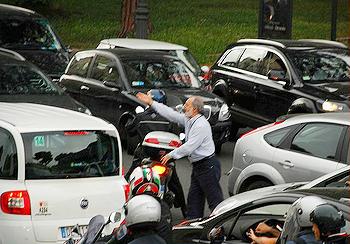
STRASBOURG, France, December 20, 2012 (ENS) – Vehicle noise limits must be lowered to protect the health of EU citizens, said Environment Committee MEPs, who approved a legislative update on Tuesday by 30 votes to 27, with two abstentions.
In their last meeting before the new year, the committee also recommended introducing a labeling scheme to inform buyers about the noise levels of new cars.

Some vehicles will have to make more noise. The proposed new regulation would set standards for the audibility of silent electric vehicles for vulnerable road users. The option for automakers to equip their vehicles with the Acoustic Vehicle Alerting System (AVAS) will remain voluntary but should be harmonized across the industry.
MEPs asked for an assessment of what the role of the AVAS system should be in the EU-wide effort to improve road safety.
Persistent exposure to high levels of traffic noise may exhaust physical reserves, disrupt proper functioning of organs and lead to development of cardiovascular and other diseases, the committee said in a statement announcing the vote.
Half of the urban population across the European Union is exposed to noise levels above 55 db as a result of ambient road noise, said the MEPs.
“This regulation has been discussed in the Environment Committee for a year now and I am convinced it will help to protect health of EU citizens against the negative effects of motor vehicle noise,” said rapporteur Miroslav Ouzký, of the Czech Republic who belongs to the European Conservatives and Reformists Party, ECR.
The proposed regulation sets lower sound limits for new vehicles in category M, for passengers, and cateogry N, for goods.
The noise reduction, taking effect six years after the regulation enters into force, would first apply to the approval of new vehicle types.
Subject to proper assessment of their impact on car industry, new limits should be reviewed and, if necessary, adapted. They would then apply for all new vehicles that will be registered, sold or will enter into service in the EU.
By a margin of one vote, the Environment Committee supported slightly more stringent limits on sound emissions than those proposed by the rapporteur and the ECR, the center-right European People’s Party and the far right Europe of Freedom and Democracy Party.

A proposal by the left-leaning Socialists and Democrats, the Alliance of Liberals and Democrats for Europe, the Greens/European Free Alliance and the European United Left/Nordic Green Left groups, which goes further, was adopted by 29 votes in favour to 28 against, with two abstentions.
Green environment spokesperson Satu Hassi of Finland called the outcome “a timid step in the right direction towards quieter roads.”
“MEPs have today voted to muffle vehicle noise,” said Hassi. “While the Greens believe tougher rules would be eminently possible for carmakers and clearly in the interest public health, today’s outcome on noise limit values is nonetheless welcome, given the background of intense lobbying from noisy car makers.”
After the vote Ouzký said the outcome could harm the industry. “Contrary to our proposal, which was realistic, the one adopted by the committee is over-ambitious,” he said. “It will only hurt the European automotive industry by reducing its ability to compete and might even lead to its destruction.”
“As the plenary debate might introduce some changes to the text adopted today, I recommend not to start any negotiations with the Council until we have support of the entire House,” said Ouzký.
To better inform consumers about the noise levels of vehicles they are about to buy, the Environment Committee MEPs called on the European Commission to introduce a new labeling scheme like those already used for to show fuel consumption, tire noise and CO2 emissions.
Information on vehicle noise levels should also be available in technical promotional materials at all points of sale, they add.
Current legislation setting sound level limits for motor vehicles was originally adopted in 1970, when the EU harmonized member states’ differing technical requirements. It has been updated several times since then, most recently in 2007.
The plenary vote on the new rule is scheduled for the March session in Strasbourg. The final legislation will have to win approval of both the European Parliament and the Council.
Copyright Environment News Service (ENS) 2012. All rights reserved.
© 2012, Environment News Service. All rights reserved. Content may be quoted only with proper attribution and a direct link to the original article. Full reproduction is prohibited.
